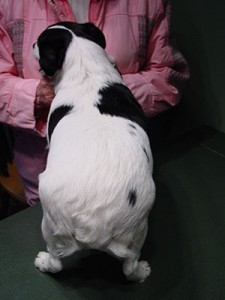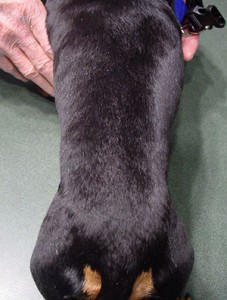If your dog is 10 percent over his ideal body weight, he is overweight. If he’s more than 30 percent over his optimal weight, we call him obese. Unbelievably, obesity strikes more than 30 percent of dogs and the incidence is rising. Look at the pictures below. Which one is fat and which one is just right?
Obesity is partly due to ignorance – owners not making the right choices about diet and exercise for their canine friends. However, even owners that recognize their dogs are obese often do not think it is an issue. Nothing could be farther from the truth.
Fat isn’t just a layer under the skin. It is in every crevice of the body. If you were to cut a fat dog in half, you’d see it between muscles and organs, throughout the liver, surrounding the heart, and even behind the eye.
Obesity creates stress on joints, which in turn predisposes them to injury, arthritis, and pain. Just as it does in people, excessive fat increases a dog’s predilection to diabetes. The risk of cancer and liver disease is also higher in fat dogs. Some dogs become so obese that they aren’t able to breathe because fat crowds out their lungs.
In 2006, researchers revealed the serious consequences of canine obesity in the Journal of the American Veterinary Medical Association. The study followed forty-eight Labrador Retriever puppies over 15 years. As pups, they were assigned to one of two groups. In the first group, the pups were allowed to eat all they wanted for their entire lives. The other group received 25 percent less food. Imagine how the groups looked – half the Labs were rotund; the other half lean.
Though there were many differences recorded between the two groups, two findings were profound. First, the incidence of orthopedic disease. For instance, hip dysplasia appeared on radiographs of the obese dogs at just six years of age. In their lean counterparts, it took a full 12 years to show up. Based on these findings, there is no doubt that you can minimize arthritic changes associated with hip dysplasia by keeping your dog lean.
Second, while the fat dogs lived, on average, 11.2 years, the thin dogs lived to 13.2 years. This study proves that you can increase your dog’s longevity by keeping him in optimal condition.
How can you tell if your dog is overweight? The easiest way to assess his body condition is to do a rib check. Put your hand on the side of your dog’s chest and palpate his ribs. If your dog is lean, you will be able to feel each rib with light pressure. If you have to push your fingers through fat to detect a rib, he is at least 10 percent overweight. If you can’t feel a rib no matter how hard you try, your dog has to shed more than 25 percent of his current weight to reach optimal condition.
Next, straddle your dog, put your hands on each side of his chest, and stroke backward. As you go off his ribs, your hands should come closer together. A trim dog has an obvious waist. Overweight dogs develop “love handles” – little (or sometimes big) bulges in front of the hips.
Why do dogs get fat? Sometimes, they have medical conditions. For example, if a dog has an inactive thyroid gland (hypothyroidism), he does not burn calories as fast as normal dogs because he has a low metabolic rate. The dog is prone to weight gain.
But, medical reasons for pudginess are rare. The real cause of canine obesity is too much food combined with too little exercise.
Consider a middle-aged 15 pound dog that gets moderate exercise. The amount of dry food he needs to maintain his weight may be one cup a day. If this cup is measured as a heaping cup rather than a level one, he will get 10 percent more than his requirement. If his owner feeds him that little bit extra day after day, it adds up. After a year, it can cause him to gain two pounds. It’s like a 180 pound man putting on 24 pounds in a year. Weight gain is amplified in sedentary dogs because they burn less calories than their active counterparts.
So, if you have a fat dog, what can you do?
The first thing to consider is your dog’s food intake. We’ve already talked about the importance of food quantity. You should feed your dog a precisely measured amount of food each day, divided into two meals. If your dog is fat, you can immediately cut down the amount you currently feed by 25 percent.
Second, you should choose an appropriate diet for your dog. You can use the food you’ve always fed your friend as long as you reduce the volume.
Third, you must exercise your dog. Exercise is a great anti-obesity tool because it helps burn calories and convert fat into muscle. Muscle burns calories faster than fat so it further accelerates weight loss.
If your dog is fat, start an exercise program slowly – do not overtax his body. A fat dog can injure himself if you suddenly ask him to go too far, too fast. In the beginning, you may ask him to amble around the block. As time goes on, his endurance will build, so you will be able to go further. Regular exercise is required – dogs should be walked once or twice every day.
When you embark on a weight reduction program for your canine friend, Find out your dog’s start weight and determine your goal. Find out how many pounds he needs to shed. Your veterinarian can help you determine your dog’s ideal body weight.
Once you begin, reweigh your dog every four weeks. If he’s dropping pounds consistently, you are giving the right amount of food and exercise. If he’s not losing weight, decrease the amount of food you offer him and/or increase his exercise.
Once your four-legged companion reaches his optimal weight, you will notice that he has more energy and can move faster. Periodically reweigh him to make sure his weight doesn’t creep back up. If you can keep him in lean body condition, you will keep him with you longer.
Dr. Louise Janes D.V.M. & Dr. Jeff Grognet D.V.M.
 Mid-Isle Veterinary Hospital
Mid-Isle Veterinary Hospital
5-161 Fern Road West
Qualicum Beach, BC
Tel (250) 752-8969
See all articles by Dr. Louise Janes D.V.M. & Dr. Jeff Grognet D.V.M.





